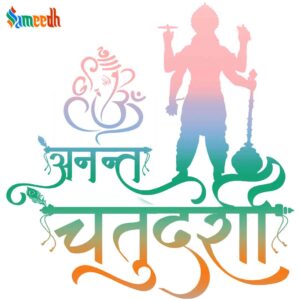Anant Chaturdashi is a Hindu festival that is celebrated on the 14th day of the lunar month of Bhadrapada, which typically coincides with the month of September. It is dedicated to the god Anant, who is a form of the god Vishnu and is believed to be the eternal and infinite one.

Anant Chaturdashi is a Hindu festival that is celebrated on the 14th day of the lunar month of Bhadrapada, which typically coincides with the month of September. The festival is dedicated to the god Anant, who is a form of the god Vishnu and is believed to be the eternal and infinite one. Anant Chaturdashi is also known as Anant Chaturdashi Vrat or Anant Chaudas.
Anant Chaturdashi is an important Hindu festival observed primarily in the states of Maharashtra, Gujarat, Rajasthan, and Uttar Pradesh, among others. It falls on the 14th day (Chaturdashi) of the Shukla Paksha (waxing moon) in the month of Bhadrapada, according to the Hindu lunar calendar. This festival marks the conclusion of the 10-day Ganesh Chaturthi festival, during which devotees immerse the idols of Lord Ganesh in water, a ritual known as “Ganpati Visarjan.”
Significance:
Anant Chaturdashi holds deep religious and cultural significance in Hindu tradition, marked by the convergence of devotion to Lord Ganesh and Lord Vishnu. Here’s a detailed look at its significance:
1. Conclusion of Ganesh Chaturthi
- Farewell to Lord Ganesh: Anant Chaturdashi marks the final day of the 10-day Ganesh Chaturthi festival. On this day, devotees bid farewell to Lord Ganesh by performing the immersion (Visarjan) of his idol in a water body. This ritual symbolizes the cycle of creation and dissolution in the universe and the belief that Ganesh will return the following year to bless them again.
- Cultural and Community Bonding: The processions leading to the immersion are grand and vibrant, with music, dance, and communal participation, fostering a sense of unity and collective celebration among devotees.
2. Worship of Lord Vishnu (Anant Puja)
- Anant Form of Vishnu: Anant Chaturdashi is also dedicated to Lord Vishnu in his infinite form, known as “Anant” (meaning infinite or endless). This day is significant for seeking blessings for infinite prosperity, happiness, and protection from Lord Vishnu.
- Anant Sutra: As part of the ritual, devotees perform the Anant Puja, where they tie a sacred thread, called Anant Sutra, with 14 knots on their wrist. This thread is believed to bring long-term protection and divine blessings. The 14 knots represent the 14 worlds in Hindu cosmology, symbolizing a connection with the divine.
- Vow of Anant: Some devotees observe a vow (vrata) on this day, which may last for 14 years. This vow is a commitment to worship Lord Vishnu and seek his blessings for stability and eternal happiness.
3. Spiritual Reflection and Renewal
- Cycle of Life and Rebirth: The immersion of the Ganesha idol in water, where it dissolves, represents the transient nature of life. It serves as a reminder of the cyclical nature of existence, where creation and dissolution are continuous processes.
- Renewal of Faith: Anant Chaturdashi is a day of spiritual reflection, renewal of faith, and reaffirmation of devotion to the divine. It encourages devotees to introspect on the infinite nature of the universe and their place within it.
4. Cultural Significance
- Celebration of Art and Tradition: The festival is also a celebration of art and tradition, with beautifully crafted Ganesh idols, traditional music, and dance performances. It is a time for communities to come together and honor their cultural heritage.
- Promoting Environmental Awareness: In recent years, there has been a growing emphasis on eco-friendly practices during the Visarjan, promoting the use of biodegradable materials for the idols and awareness about protecting water bodies.
5. Social Unity
- Collective Worship and Celebration: Anant Chaturdashi, particularly in regions like Maharashtra, is a time when people from diverse backgrounds come together to celebrate, fostering social harmony and collective worship.
In essence, Anant Chaturdashi is a festival that blends devotion, cultural expression, and spiritual reflection, making it a day of both joyous celebration and profound religious significance.
Observances:
People fast and pray for the well-being of their families, and many also observe a vow to honor Lord Vishnu, which may last for 14 years, symbolizing the commitment to Lord Vishnu’s blessings.
Anant Chaturdashi is a day of both celebration and reflection, blending the joy of Ganesh Chaturthi with the spiritual observance of Anant Puja.
On Anant Chaturdashi, Hindus observe a fast and perform special puja (worship) rituals to honor the god Anant. They also recite the Anant Sahasranam (thousand names of Anant) and the Anant Ashtakam (eight verses in praise of Anant). In some regions, Anant Chaturdashi is also a time for charitable activities, such as donating food or clothing to those in need.
Anant Chaturdashi is an important festival for Hindus, as it is believed to bring good fortune and blessings from the god Anant. It is also a time for spiritual devotion and self-reflection.
Food
On Anant Chaturdashi, Hindus who are observing the fast typically abstain from consuming food or water for the duration of the fast. However, after the fast is completed, there are certain foods that are traditionally consumed to mark the occasion. These may include:
Sabudana khichdi: A dish made with soaked and cooked tapioca pearls, mixed with peanuts, potatoes, and spices.
Sabudana vada: A snack made with soaked and ground tapioca pearls, mixed with spices and deep-fried.
Kachauri: A snack made with dough filled with a spicy lentil mixture, deep-fried and served with chutney or yogurt.
Rajgira paratha: A flatbread made with amaranth flour and spices, served with a side of pickle or yogurt.
Fruits: A variety of fresh fruits, such as bananas, apples, and mangoes, are often consumed to break the fast.
Drinks: Traditional drinks, such as coconut water or buttermilk, are often consumed to rehydrate after the fast.
These are just a few examples of the foods that are traditionally consumed on Anant Chaturdashi. The specific foods that are eaten may vary depending on the region and personal preferences.
Attire
On Anant Chaturdashi, Hindus may dress up in traditional clothing or in their everyday attire to mark the occasion. The specific type of clothing that is worn may vary depending on the region and cultural traditions. Some common types of dresses that may be worn on Anant Chaturdashi include:
Sari: A traditional garment worn by women in South Asia, consisting of a long piece of cloth draped over the body and worn with a blouse and petticoat.
Lehenga: A traditional garment worn by women in North India, consisting of a long, full skirt and a cropped top, often worn with a dupatta (long scarf).
Choli: A cropped top that is worn with a sari or lehenga.
Salwar kameez: A traditional garment worn by women in North India and Pakistan, consisting of a long tunic worn over loose pants and a scarf.
Anarkali: A long, flowing dress that is worn with leggings or churidar pants.
Men may wear traditional Indian garments such as a dhoti (a long piece of cloth wrapped around the lower body) or a kurta (a long, loose tunic) with pyjamas (loose pants). They may also wear Western-style clothing, such as pants and a shirt.
